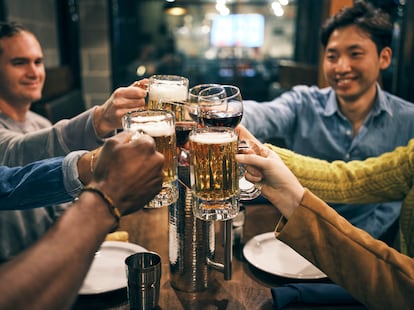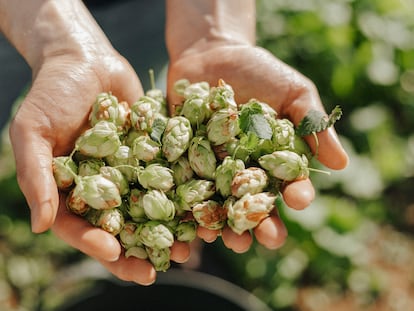The drunken monkey hypothesis: Why we like beer and wine so much
Various scientific theories have proposed that the taste for alcohol could have very ancient evolutionary roots

What was the catalyst that drove humanity towards agriculture? This is one of the great questions of anthropology. In the 1950s, bread was thought to be that catalyst, but an American botanist named Jonathan Sauer challenged this assumption and proposed beer. As of today, this debate is not yet closed.
Recent archaeological evidence indicates that humans were already brewing beer 13,000 years ago, when agriculture had not yet been introduced. We also know that the first agricultural communities who had settled in Israel, along the Black Sea and in China already made wine and beer. What is clear is that humans have always liked fermented drinks.
In fact, our evolutionary history with alcohol dates back to when we were hairy monkeys. Let’s place ourselves in a lush tropical forest, where the environment is warm and humid. When the fruit ripens, a fraught competition begins to access the valuable sugar they contain. This includes frugivorous (fruit-eating) animals, but also microorganisms. Yeasts in particular have developed a strategy to eliminate their competition. Using fermentation, they convert sugar into ethanol, which is harmful to bacteria.
Now let’s think about the little monkeys that jump from tree to tree in search of food. For them, the ethanol that emanates from ripe fruit is a very valuable clue to finding it. Natural selection could have acted on frugivorous animals to associate alcohol with a nutritional reward. Therefore, it is likely that alcohol is a common component in the diet of many primates. These ideas, proposed by Rober Dudley in an article published in 2000, are known as the “drunken monkey hypothesis,” which currently has a lot of evidence. We know that wild primates consume fermented fruits and that they are very sensitive to the smell of ethanol. It has also been shown that frugivorous mammals do not identify this substance as toxic, and there is a correlation between the amount of alcohol a species consumes and its genetic ability to metabolize it.
Curiously, humans and other great apes are better adapted to alcohol intake than other primates. Multiple pathways are involved in metabolizing this substance, which usually begins with the action of the enzyme alcohol dehydrogenase (ADH). There are many versions of this enzyme, each specialized in a different type of alcohol. One of them is ADH4, very efficient at metabolizing geraniol, an alcohol produced by plants in the leaves, but is inefficient with ethanol.
About 10 million years ago, a mutation appeared in ADH4 that allowed ethanol to be oxidized about forty times better than before. It occurred in a common ancestor between humans and African great apes. In fact, chimpanzees’ taste for alcohol is also well known. In Guinea, locals harvest fermented palm sap. They puncture the trees and place plastic containers that collect the sap that flows throughout the night. The chimpanzees have learned the trick and love to drink the sap, which contains 3% alcohol, from the containers.
This behavior is unnatural, because normally chimpanzees would not have access to this sap, but it shows how prone our closest relatives are to drinking alcohol. Since these chimpanzees weigh on average less than a human, they may occasionally become intoxicated.
There is also some other primate with the same mutation, such as the aye-aye, where it has evolved independently. Both it and the slow loris feed on fermented palm nectar containing a high concentration of alcohol, but they show no signs of intoxication. A study published in 2016 showed that both species can distinguish between drinks with different degrees of alcohol and that they prefer the strongest one.
Thanks to a single amino acid change in ADH4, aye-aye can exploit valuable food resources. It probably also gave our ancestors an evolutionary advantage in an environment and time in the past.
Let’s travel about 24 million years back in time, to the early Miocene, the golden age of primate evolution. During this time the first apes appeared in East Africa. They lived in the trees of tropical forests and fed mainly on fruit. They quickly diversified and, 17 million years ago, there were at least 14 different genera. At this same time, the sea level fell due to global cooling and many species of apes migrated from Africa to Eurasia.
For the species that stayed in Africa, the climate was still warm and humid enough for year-round fruit, but in Europe the cold was more severe and the habitat changed to deciduous forests with open grasslands. The availability of fruit in the winter months was reduced and the apes began to starve, as suggested by the teeth found from this time.
About 8 million years ago, there were no ape species left in Europe. Some had become extinct and others had emigrated. Those that went to Asia gave rise to the orangutan lineage, and those that returned to Africa preceded gorillas, chimpanzees and humans.
These apes that returned to Africa had adapted to spending more time on the ground, where they could find fruit that had fallen from trees and other types of food such as tubers and roots. Furthermore, they found an East Africa very different from the one their ancestors had left behind. Volcanic activity in the Rift Valley had favored a transition towards savanna habitat, where our bipedal ancestors evolved.
This is the period in which the ADH4 mutation occurred. That’s why humans share the ability to metabolize alcohol better with chimpanzees and gorillas, but not with orangutans. This helped our survival by allowing us to eat the highly fermented fruit that we found on the ground without becoming poisoned.
However, what was an advantage 10 million years ago does not have to be so now, as is the case with sugar. The strong attraction we feel for sugar has ended up turning against us and, in today's societies, where we can eat as much as we want, diseases such as diabetes and obesity abound.
Something similar could be happening with alcohol. Controlled doses of this substance, such as those we would find in a natural environment, do not have to be harmful, but now we have drinks with a high level of alcohol within easy reach. According to some scientists, the greater ability of our ancestors millions of years ago to metabolize and use ethanol from fermented fruit fermented may be favoring the high rates of alcoholism today.
Sign up for our weekly newsletter to get more English-language news coverage from EL PAÍS USA Edition
Tu suscripción se está usando en otro dispositivo
¿Quieres añadir otro usuario a tu suscripción?
Si continúas leyendo en este dispositivo, no se podrá leer en el otro.
FlechaTu suscripción se está usando en otro dispositivo y solo puedes acceder a EL PAÍS desde un dispositivo a la vez.
Si quieres compartir tu cuenta, cambia tu suscripción a la modalidad Premium, así podrás añadir otro usuario. Cada uno accederá con su propia cuenta de email, lo que os permitirá personalizar vuestra experiencia en EL PAÍS.
¿Tienes una suscripción de empresa? Accede aquí para contratar más cuentas.
En el caso de no saber quién está usando tu cuenta, te recomendamos cambiar tu contraseña aquí.
Si decides continuar compartiendo tu cuenta, este mensaje se mostrará en tu dispositivo y en el de la otra persona que está usando tu cuenta de forma indefinida, afectando a tu experiencia de lectura. Puedes consultar aquí los términos y condiciones de la suscripción digital.
More information
Últimas noticias
Most viewed
- Sinaloa Cartel war is taking its toll on Los Chapitos
- Oona Chaplin: ‘I told James Cameron that I was living in a treehouse and starting a permaculture project with a friend’
- Reinhard Genzel, Nobel laureate in physics: ‘One-minute videos will never give you the truth’
- Why the price of coffee has skyrocketed: from Brazilian plantations to specialty coffee houses
- Silver prices are going crazy: This is what’s fueling the rally











































